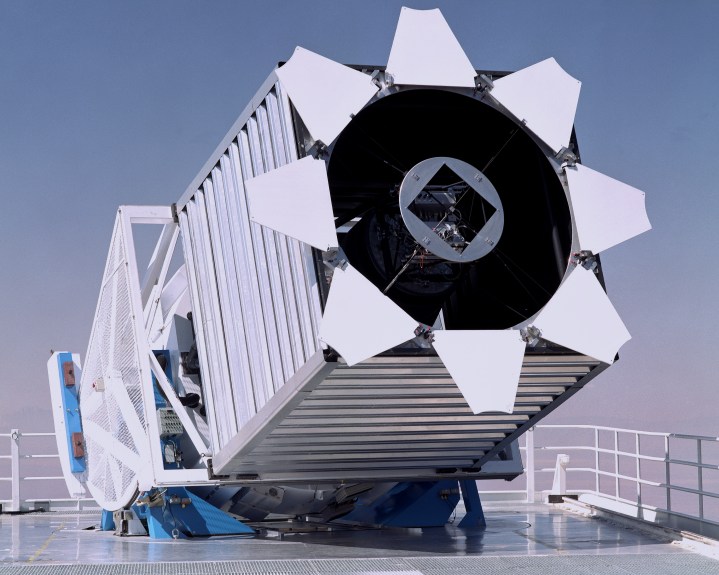Reverberation Mapping (eBOSS)
eBOSS has only one ancillary program: the Reverberation Mapping (RM) program is a multi-epoch spectroscopic survey designed to enable use of the reverberation mapping technique to study the structure of broad-line regions in AGN and quasars.
Contact

| Yue Shen |
|---|
| University of Illinois |
| shenyue@illinois.edu |
Reverberation Mapping Program
A multi-epoch spectroscopic survey designed to enable use of the reverberation mapping technique to study the structure of broad-line regions in AGN and quasars
Finding Targets
An object whose ANCILLARY_TARGET2 value includes one or more of the bitmasks in the following table was targeted for spectroscopy as part of this ancillary target program. See SDSS bitmasks to learn how to use these values to identify objects in this ancillary target program.
| Program (bit name) | Bit number | Target Description | Spectra | Unique Primary Objects |
|---|---|---|---|---|
| RM_TILE1 | 54 | Reverberation mapping program, high priority | 11,270 | 230 |
| RM_TILE2 | 55 | Reverberation mapping program, low priority | 30,331 | 619 |
Description
The broad emission lines in AGN spectra can have flux variations correlated with variation in the continuum, but with a time delay interpreted as the mean light-travel time across the broad-line region. Measuring this time delay — a technique known as reverberation mapping — allows researchers to study the structure and kinematics of the broad-line regions of AGN.
This program obtained repeated spectroscopy of 849 spectroscopically-confirmed quasars during 2014-2017 (within SDSS-III/BOSS and SDSS-IV/eBOSS), with the goal of studying the variability of this sample. Observations were scheduled with a cadence of four to five days in 2014 (BOSS) and 2/month in 2015-2017 (eBOSS), weather permitting, in order to detect broad-line time delays on both short (<6 months) and long timescales. Typical exposure times were 2 hours/epoch for the 2014 observations and 1 hour/epoch for the 2015-2017 observations. The survey is described in Shen et al. (2015a). Initial results on time delay measurements are described in Shen et al. (2016). The high cadence sequence of observations and the resulting deep co-added spectra allow additional unique analyses beyond reverberation mapping. For example, the sample has been used to measure host galaxy properties for broad-line quasars at 0.1 < z < 1 (Shen et al. 2015b, Matsuoka et al. 2015), to spectroscopically characterize general quasar variability (Sun et al. 2015), and to identify variability of intrinsic quasar absorption lines (Grier et al. 2015).
Caveat
A known issue of the RM plates taken during SDSS-IV/eBOSS (e.g., MJD ≥ 57038) is that on some plates there is a mismatch between the targets from plugmap and the fiber spectra for certain objects. This issue most heavily affected on plate 7339-57518 but also occasionally on other eBOSS-RM plates as well. We are in the process of investigating the origin of this problem and manually fixing these mismatched cases on a plate-by-plate basis. The frequency of these events, however, is low (< 0.1%).
Target Selection
Previous spectroscopy of the PS1 Medium Deep Field MD07 (RA = 213.704 deg, DEC = +53.083 deg) provided redshifts of roughly 1,200 quasars in the redshift range 0 < z < 5 over the area of a single plate. The sample was limited to quasars with i < 21.7. Quasars whose time delay should be easier to measure (e.g., lower redshifts, strong broad emission lines) were given higher priority, and these are indicated by the RM_TILE1 target class; essentially all of these targets were assigned a fiber. Lower-priority targets, indicated by the RM_TILE2 target class, were tiled with the remaining fibers. Three plates containing identical science targets were drilled at varying hour angle to ensure that the field was visible for six months. Each plate was given the normal number of sky fibers (80), but was allocated a substantially larger number of standard star fibers (70 rather than the usual ~20) to allow more rigorous tests of spectrophotometric calibration.
Papers describing (results from) the RM program
Denney, K.D., et al. 2016, ApJ, 833, 33
Denney, K.D., et al. 2016, ApJS, 224, 14
Grier, C.J., et al. 2015, ApJ, 806, 111
Grier, C.J., et al. 2017, ApJ, 851, 21
Li, J., et al. 2017, ApJ, 846, 79
Matsuoka, Y., et al. 2015, ApJ, 811, 91
Shen, Y., et al. 2015a, ApJS, 216, 4
Shen, Y., et al. 2016, ApJ, 831, 7
Shen, Y., et al. 2015b, ApJ, 805, 96
Shen, Y., et al. 2016, ApJ, 818, 30
Sun, M., et al. 2015, ApJ, 811, 42
Sun, M., et al. 2018, ApJ, 854, 128
Yue M., et al. 2018, ApJ, in press, arXiv:180609083
REFERENCES
Grier, C.J., et al. 2015, ApJ, 806, 111
Matsuoka, Y., et al. 2015, ApJ, 811, 91
Shen, Y., et al. 2015a, ApJS, 216, 4
Shen, Y., et al. 2015b, ApJ, 805, 96
Shen, Y., et al. 2016, ApJ, 818, 30
Sun, M., et al. 2015, ApJ, 811, 42


